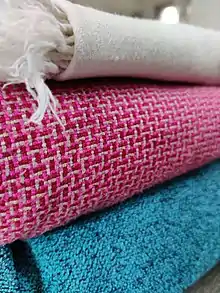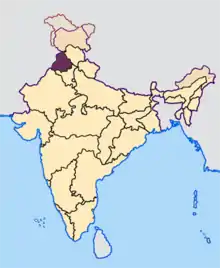Khes
Khes (Punjabi: ਖੇਸ੍) (Punjabi pronunciation: [kʰeːsː]) is a thin cotton blanket cloth of the Indian subcontinent; it is a damask cloth used for blankets and winter wraps.[1][2] Khes is generally hand-woven with coarse cotton yarns. Khes as a garment is a simple clothing item to wear loosely to cover upper body parts by men in Punjab, India, and Pakistan. Khes was an important cloth of Indian Punjab,[3] and also produced in Punjab, Pakistan. The Punjab region was famous for the production of khes and many coarse cotton textiles produced in the 19th and 20th centuries.[4][5] Khes is a comfort object used in bedding, and also usable as a cover.[6] [7][8][9][10][11]
Khes weaving
Weave
Khes is a thick woven cloth made on a handloom. Khes weaving was a traditional textile art associated with rural Punjab. The craft of khes-weaving had cultural significance in rural areas.[12][13] Women in villages used to weave khes.[14]
Spans of khes were traditionally woven in pairs and then stitched together.[15] Khes pieces from the town of Rampur, Uttar Pradesh, were larger and available in sizes up to 6 by 9 feet (2.75 by 1.8 m).[16]
Khesi [17]is a wider variant of khes, for use in making robes as robes and sheets.[1]
Patterns
Most khes were made of cotton, but there were some varieties of cotton and silk also.[18] [19]Khes varieties were distinguished with different weave patterns and origin. Primarily Khes was plain or with geometrical designs, including check pattern (charkhana, chequered) and diamond patterns.[7] The frequency of the checked style has led to khes sometimes being referred to as a type of tartan cloth[3] (a term more often reserved for Scottish textiles). Dabba khes is a pattern with squares formed using dyed yarns.[20][21] Khes from Rampur State was famous for its superior-quality cotton and unique, interwoven patterns, often with gold thread and borders in various coloured yarns.[22] [23] Khes patpatti had white and red check patterns, while khes tukridaar was the name for white and blue checks.[24] Khesbaf weaving was the term for forming diagonal patterns.[24]
Production sites
The most notable production sites in India were the Malwa region, and Bahawalpur, Multan, and southern Indian Punjab.[25] Others included Rampur, Uttar Pradesh;[16] and Rampur State.[22][23]
Production in Pakistan took place in the town of Naserpur,[26] Sehwan,[27][28] and Thatta[29] (all in Sindh); and villages in the Cholistan Desert (of southern Pakistani Punjab.[30]
See also
References
- Tortora, Phyllis G.; Johnson, Ingrid (2013-09-17). The Fairchild Books Dictionary of Textiles. A&C Black. pp. 327, 357, 361. ISBN 978-1-60901-535-0.
- Mukharji, T. N. (1888). Art-manufactures of India. Gerstein - University of Toronto. Calcutta. p. 323.
- "The Lost Tartan Khes of India – Global InCH- International Journal of Intangible Cultural Heritage". Retrieved 2020-11-30.
- Parshad, Gopal (2007). Industrial Development in Northern India: A Study of Delhi, Punjab and Haryana, 1858-1918. National Book Organisation. ISBN 978-81-87521-20-4.
- Punjab (India) (2000). Punjab State Gazetteer. Revenue and Rehabilitation Department, Punjab. pp. 299, 566.
- A. BISWAS. Indian Costumes.
- Baden-Powell, Baden Henry (1872). Hand-book of the Manufactures & Arts of the Punjab: With a Combined Glossary & Index of Vernacular Trades & Technical Terms ... Forming Vol. Ii to the "Hand-book of the Economic Products of the Punjab" Prepared Under the Orders of Government. Punjab printing Company. pp. 6, 16, 22.
- Rutnagur, Sorabji M. (1984). The Indian Textile Journal. Business Press. p. 139.
- Industries, Pakistan Ministry of; Yacopino, Feliccia (1977). Threadlines Pakistan. Ministry of Industries, Government of Pakistan.
- Askari, Nasreen; Crill, Rosemary; Museum, Victoria and Albert (1997). Colours of the Indus: Costume and Textiles of Pakistan. M. Holberton. pp. 12, 88, 142. ISBN 978-1-85894-044-1.
- . Encyclopædia Britannica. 14 (11th ed.). 1911. pp. 375 to 421.
- Gupta, Suchitra (1973). "THE BRITISH IMPACT ON THE INDIGENOUS COTTON TEXTILE INDUSTRY OF THE PUNJAB 1875 to 1885". Proceedings of the Indian History Congress. 34: 122–128. ISSN 2249-1937. JSTOR 44138701.
- "The Khes of Punjab". Retrieved 2020-12-05.
- Askari, Nasreen; Crill, Rosemary (1997). Colours of the Indus: Costume and Textiles of Pakistan. M. Holberton. p. 88. ISBN 978-1-85894-045-8.
- Arts and Crafts of Pakistan. Export Promotion Bureau, Government of Pakistan. 1994. p. 47.
- Pradesh (India), Uttar (1959). Uttar Pradesh District Gazetteers: Allahabad. Government of Uttar Pradesh. p. 133.
- "Punjabi Dressing | Coloursofpunjab". 2015-05-03. Archived from the original on 2015-05-03. Retrieved 2020-12-08.
- Askari, Nasreen (1999). Uncut cloth. Internet Archive. London : Merrell Holberton. pp. 84, 90. ISBN 978-1-85894-083-0.
- Watt, George Sir; Brown, Percy (Illus ) (1903). Indian Art at Delhi, 1903; being the Official Catalogue of the Delhi Exhibition, 1902-1903. Superintendent of Government Printing (Calcutta). p. 528.
- Punjab District and State Gazetteers: Part A]. Compiled and published under the authority of the Punjab government. 1916. p. 196.
- Proceedings - Punjab History Conference. 2003. p. 103. ISBN 978-81-7380-885-2.
- Gazetteer of the Rampur State. W.C. Abel, Government Press, United Provinces. 1911. p. 34.
- Mukhopādhyāẏa, Trailokyanātha (1888). Art-manufactures of India: Specially Compiled for the Glasgow International Exhibition, 1888. Superintendant of Government Printing. p. 321.
- Baden-Powell, Baden Henry (1872). Hand-book of the Manufactures & Arts of the Punjab: With a Combined Glossary & Index of Vernacular Trades & Technical Terms ... Forming Vol. Ii to the "Hand-book of the Economic Products of the Punjab" Prepared Under the Orders of Government. Punjab printing Company. p. 16.
- Harris, Jennifer (2020-09-16). A Companion to Textile Culture. John Wiley & Sons. p. 176. ISBN 978-1-118-76890-7.
- Industries, Pakistan Ministry of; Yacopino, Feliccia (1977). Threadlines Pakistan. Ministry of Industries, Government of Pakistan. pp. 60, 63.
- Arts and Crafts of Pakistan. Export Promotion Bureau, Government of Pakistan. 1994. p. 40.
- Sind Quarterly. Shah Abdul Latif Cultural Society. 1994.
- Fanthorpe, Helen, ed. (2020). Insight Guides Pakistan (eBook ed.). Apa Publications. "Textiles" section. ISBN 9781839052583. Retrieved 4 December 2020 – via Google Books.
- Claus, Peter J.; Diamond, Sarah; Mills, Margaret Ann (2003). South Asian Folklore: An Encyclopedia – Afghanistan, Bangladesh, India, Nepal, Pakistan, Sri Lanka. Taylor & Francis. p. 394. ISBN 978-0-415-93919-5.



